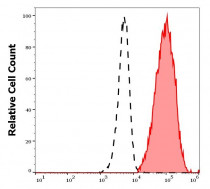ARG65499
anti-CD3 epsilon antibody [MEM-57] (low endotoxin)
anti-CD3 epsilon antibody [MEM-57] (low endotoxin) for CyTOF®-candidate,Flow cytometry,Functional study,Immunoprecipitation and Human
Cancer antibody; Developmental Biology antibody; Immune System antibody; Lymphocyte Marker antibody; Inflammatory Cell Marker antibody; T-cell Marker antibody; T-cell infiltration Study antibody; Tumor-infiltrating Lymphocyte Study antibody
Overview
| Product Description | Azide free and low endotoxin Mouse Monoclonal antibody [MEM-57] recognizes CD3 epsilon |
|---|---|
| Tested Reactivity | Hu |
| Tested Application | CyTOF®-candidate, FACS, FuncSt, IP |
| Specificity | The clone MEM-57 reacts with gamma-epsilon and delta-epsilon dimers of human CD3 complex, a part of a bigger multisubunit T cell receptor complex (CD3/TCR) expressed on peripheral blood T lymphocytes and mature thymocytes. HLDA IV.; WS Code T 96 |
| Host | Mouse |
| Clonality | Monoclonal |
| Clone | MEM-57 |
| Isotype | IgG2a |
| Target Name | CD3 epsilon |
| Antigen Species | Human |
| Immunogen | Human thymocytes and T lymphocytes. |
| Conjugation | Un-conjugated |
| Alternate Names | CD3E; CD3 Epsilon Subunit Of T-Cell Receptor Complex; T-Cell Surface Glycoprotein CD3 Epsilon Chain; CD3e Antigen, Epsilon Polypeptide (TiT3 Complex); T-Cell Surface Antigen T3/Leu-4 Epsilon Chain; CD3e Molecule, Epsilon (CD3-TCR Complex); CD3-Epsilon; CD3epsilon |
Application Instructions
| Application Suggestion |
|
||||||||||
|---|---|---|---|---|---|---|---|---|---|---|---|
| Application Note | IP: The clone MEM-57 immunoprecipitates from a detergent lysate of surface-radioiodinated T cells a strong zone of about 22 kDa and a weak 28 kDa zone, which is typical pattern yielded by a reference antibody Leu-4 (SK7). Functional studies: The clone MEM-57 has strong mitogenic effect on peripheral T lymphocytes; It reacts strongly with gamma/delta T lymphocytes. * The dilutions indicate recommended starting dilutions and the optimal dilutions or concentrations should be determined by the scientist. |
||||||||||
| Positive Control | FACS: Jurkat |
Properties
| Form | Liquid |
|---|---|
| Purification | Purification with Protein A. |
| Purification Note | 0.2 µm filter sterilized. Endotoxin level is <0.01 EU/µg of the protein, as determined by the LAL test. |
| Purity | > 95% (by SDS-PAGE) |
| Buffer | PBS (pH 7.4) |
| Concentration | 1 mg/ml |
| Storage Instruction | For continuous use, store undiluted antibody at 2-8°C for up to a week. For long-term storage, aliquot and store at -20°C or below. Storage in frost free freezers is not recommended. Avoid repeated freeze/thaw cycles. Suggest spin the vial prior to opening. The antibody solution should be gently mixed before use. |
| Note | For laboratory research only, not for drug, diagnostic or other use. |
Bioinformation
| Database Links |
Swiss-port # P07766 Human T-cell surface glycoprotein CD3 epsilon chain |
|---|---|
| Gene Symbol | CD3E |
| Gene Full Name | CD3 Epsilon Subunit Of T-Cell Receptor Complex |
| Background | The protein encoded by this gene is the CD3-epsilon polypeptide, which together with CD3-gamma, -delta and -zeta, and the T-cell receptor alpha/beta and gamma/delta heterodimers, forms the T-cell receptor-CD3 complex. This complex plays an important role in coupling antigen recognition to several intracellular signal-transduction pathways. The genes encoding the epsilon, gamma and delta polypeptides are located in the same cluster on chromosome 11. The epsilon polypeptide plays an essential role in T-cell development. Defects in this gene cause immunodeficiency. This gene has also been linked to a susceptibility to type I diabetes in women. |
| Function | Part of the TCR-CD3 complex present on T-lymphocyte cell surface that plays an essential role in adaptive immune response. When antigen presenting cells (APCs) activate T-cell receptor (TCR), TCR-mediated signals are transmitted across the cell membrane by the CD3 chains CD3D, CD3E, CD3G and CD3Z. All CD3 chains contain immunoreceptor tyrosine-based activation motifs (ITAMs) in their cytoplasmic domain. Upon TCR engagement, these motifs become phosphorylated by Src family protein tyrosine kinases LCK and FYN, resulting in the activation of downstream signaling pathways. |
| Cellular Localization | Cell membrane, Membrane |
| Highlight | Related products: CD3 antibodies; CD3 ELISA Kits; CD3 Duos / Panels; CD3 recombinant proteins; Anti-Mouse IgG secondary antibodies; Related news: New antibody panels and duos for Tumor immune microenvironment Tumor-Infiltrating Lymphocytes (TILs) Exploring Antiviral Immune Response |
| Research Area | Cancer antibody; Developmental Biology antibody; Immune System antibody; Lymphocyte Marker antibody; Inflammatory Cell Marker antibody; T-cell Marker antibody; T-cell infiltration Study antibody; Tumor-infiltrating Lymphocyte Study antibody |
| Calculated MW | 19 kDa |
Images (3) Click the Picture to Zoom In
-
ARG65499 anti-CD3 epsilon antibody [MEM-57] (low endotoxin) FACS image
Flow Cytometry: Human peripheral whole blood stained with ARG65499 anti-CD3 epsilon antibody [MEM-57] (low endotoxin) at 0.33 µg/ml dilution, followed by APC-conjugated Goat anti-Mouse antibody.
-
ARG65499 anti-CD3 epsilon antibody [MEM-57] (low endotoxin) FACS image
Flow Cytometry: Separation of human CD3 positive lymphocytes (red-filled) from neutrophil granulocytes (black-dashed). Human peripheral whole blood stained with ARG65499 anti-CD3 epsilon antibody [MEM-57] (low endotoxin) at 0.33 µg/ml dilution, followed by APC-conjugated Goat anti-Mouse antibody.
-
ARG65499 anti-CD3 epsilon antibody [MEM-57] (low endotoxin) CyTOF image
CyTOF: PBMC (after Ficoll-Paque separation) stained with ARG65499 anti-CD3 epsilon antibody [MEM-57] (low endotoxin) (Dy161). Singlet cells were gated for data analysis.
Clone References










